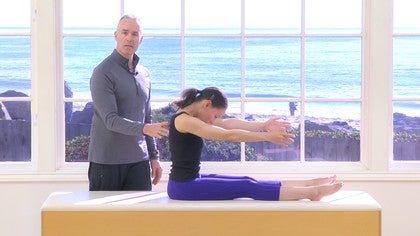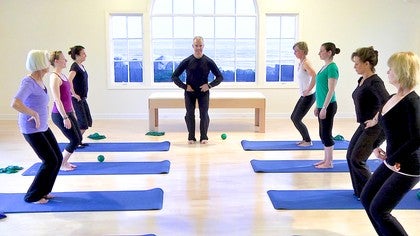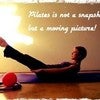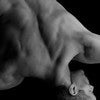Description
About This Video
Transcript
Read Full Transcript
So what does it mean to the um, inhabit your body more or another way of saying it? What does it mean that your mind is, your body's always trying to do what your mind is thinking. What that means is that your body is trying to perform what's going on in your head. So from a perspective of movement, Pilati is so great to learn how to cultivate, how to move well, how to cultivate attention and your and improve your health and wellbeing all at the same time. So you have this physical format to develop, the ability to pay attention and to notice yourself. So what are some tools to do that? One, which I recommend from the beginning in your class or when you take my class or any class, is start with just getting, still getting still and quiet, which can be difficult cause you, what you'll notice when you get still in quiet is that the brain and the mind are all over the place. The minute you close your eyes, you might notice that you're thinking about random thoughts and it's hard to bring your attention to your body. That's not unique to anybody. That's the nature of the mind. And that's how it is for all of us.
So it's a skill, it's a skill that develops selective focus. It's also the nature of the mind for it to wander. So just recognize that that's just the way it is. So okay, I'm going to bring my attention and I'm gonna start to feel my body think less than words and continue to bring my attention back to what I'm sensing and feeling. I could be standing, it could be sitting, and I'm going to notice what I'm noticing. You can use the ground and your feet to feel the ground feel. Oh, I'm bleeding a little back on my heels. I'm just going to notice what I noticed. And then what you can do from there is you can use a number of things to improve your mind, body connection to your, how you want to direct your attention to how your body moves and your experience. So let me give you an example of proprioception.
So in terms of proprioception, one way to improve it is through touch. So we'll take the shoulder grill for example. So whether you're a teacher or a student, this is, this is relevant to all of us. You don't have to understand your anatomy in a very specific way, but through touch and movement you can sense it better. And you can notice if you're using it in a way that's actually moving in a good direction.
So one thing would be you can put your hand on your collar bone and shoulder girdle and then you could take the arm and reach the arm forward. Then you'll notice that the collarbone and shoulder blade have to move together at the same time and then they move back. So you start to feel that the shoulder girdle is designed to slide around the rib cage in a fluid way. This is a great way to understand how to release neck and shoulder tension and then how this relates to a lot of the exercises you're going to do in a pilates class that help you get the best benefit and to learn how to get stronger and more conditioned without building unnecessary tension. So a little bit of self touch is great, especially in an area your body that maybe you don't feel as skilled or aware and you can do that in any area of your body.
Now I'm going to give you an example with a student with Jia of how we could do that touch process and take it into a polities exercise. All right, so here I am with Jia and we are going to demonstrate how you can use in relationship to the show the girdle to enhance her awareness of how to do the exercise that will follow, but also just to use your shoulder girdle better and touch in and of itself is a really powerful tool. So I'm gonna Have Jia put her hand on her right shoulder girdle, her left hand and just bring her left your right arm in front of her and I'm going to give her a little feedback in the back and see if if you as a teacher presence is something a teacher can do. Now her shoulder girdle goes all the way in the back here. I'm just going to have her slide of shoulder blade back into my hand. That's called retraction and then forward.
So she gets a feeling of that motion to see that the show, the grill is designed to slide around the rib cage. Now she also can take it up towards your ear. Now just take the um, shoulder girdle up and then down. So that's an option. Now when we do the spine stretch, we don't want to do that, so I'm just going to give her a cue that this is something. Take it up again, this is something you want to see if you can not do, when you do the exercises, this will be the tenancy because these muscles tend to be tighter and stronger than the lower part. Now one more time, retract and then go forward. That's a, now I'm going to have to do it on the other side. Just quickly, she's going to retract and go forward. And now an image she can use is to think of a shoulder blades sliding around the ribcage to the back and then sliding to the front. And it's designed to slide in a very fluid way around the ribcage.
This is what gives our arm more range without anyone muscle having to work to an extreme. That's enough from there. Now she's going to hold it and hold it where she began and below it bring both arms up and we're going to take it into the spine stretch. So on the exhale from the top down, she's going to curl and feel the shoulder blades slide forward and out. And on the inhale from the base of the spine, sure roll up and feel them slightly retract. And again, on the exhale she'll go forward, they'll slide down and out. And then as she comes up, they slide slightly back.
And this helps it for the neck movement to be fluid in the spine, to move in a much more easeful way. One more time,
So it can be a positive experience when you can get the most out of the movement experience. So the first thing we're going to do is have Jia turn to the side here and I'm just going to have her do simple with knees bent, flection and extension of the spine. And as she does it, I'm going to talk [inaudible] and then she's going to go into extension and I'm going to talk what could be happening when somebody is doing this? Oh my God, my back is so stiff. God, I hate this movement. I hope he doesn't make me do many more of these go. I'm feeling like I got this wrench in my back. God, my neck is so stiff. I hope this is safe for me. God, I better not do too many more of these.
Glad that's over. Oh Wow. So there's an example of some mental dialogue that can be going on. That's a maybe an extreme example, but not really. This is happening all the time. So we're going to shift that to what is some of the qualities that I would want from my spine.
So you could think of in terms of before you even start your practice or in your practice, when you're about to do an exercise. What do I want for that part of my body? So in my class I would talk to you about, now we're going to warm up the spine. So let's think about what do we want with our response. Let's think as she does the move, what we're going to think. Fluid, youthful.
So I'd like you to go right back into the same movement. Fluid, spacious, youthful, articulate, aligned, strong, joyful, happy spine. So these are all mood words that create a quality of movement. Graceful. All of these are really helpful that change the movement experience. So you can see that from me watching her move, she seems like she's going into more range and it looks more inviting to me. So there's an example of using a positive mood word directly related to how to improve your health and your moving experience.
That's very powerful and very useful in your movement, in your movement classes and for your life. So how you can use this in your class, like setting an intention in the beginning is a starting place. First of noticing yourself. And then after you notice what's happening for yourself on a feeling level, you can set an intention of what you'd like to improve and say nothing clear coms, I don't know, I'd like to feel better. You could even just say, I'd like to make progress, but if there's areas of your body that you want to improve, then you could use your own mood words, your own words to actually keep yourself in that intention throughout your class. And you'll notice the experience will change. And one of the big things that they've proved through science is that what you put attention on creates a change.
And the biggest change for our mind is our attention. So I look forward to seeing you in the class or sometime in the future, and please use this and try this out. I think you'll find it really valuable.
Mindful Movement: Creating Awareness
Comments
 ) to have my students connect to the wisdom of their bodies for a true mind/body partnership.
) to have my students connect to the wisdom of their bodies for a true mind/body partnership. Thank you PIlatesAnytime!
You need to be a subscriber to post a comment.
Please Log In or Create an Account to start your free trial.

































